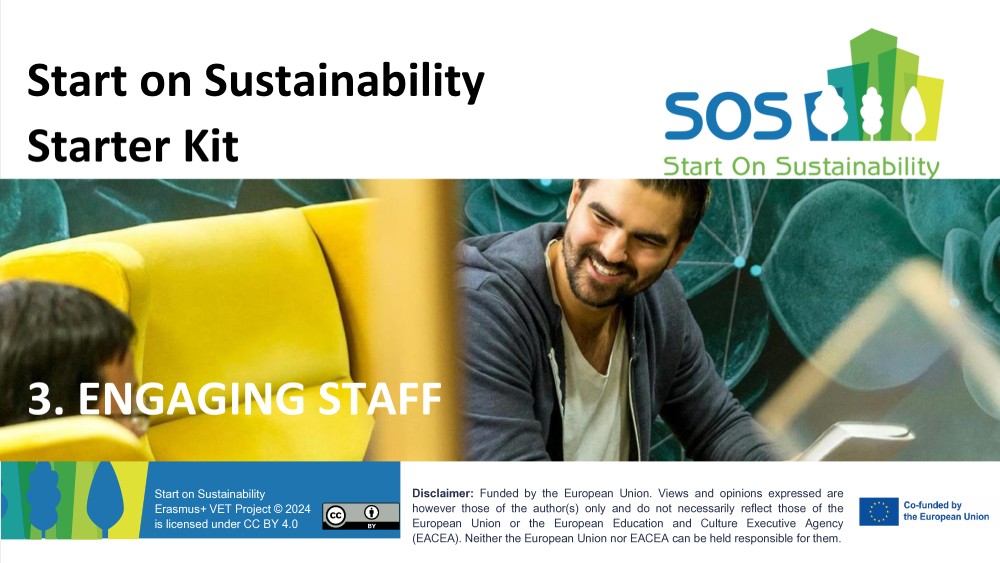
Unit 3 focuses on people. It shows how to involve employees in sustainability so it becomes part of daily work, not a side project. The unit covers practical engagement methods, advocacy, skills and training, green jobs, and inclusion.
What this unit covers
- What staff engagement means
Moving beyond awareness to active participation, ownership, and idea-sharing. - How to build momentum
Champions, team-based activities, and simple routines that make sustainable choices the default. - Advocacy and vision
Crafting a clear sustainability vision and aligning it with personal and company values. - Skills and training
Upskilling for greener operations and continuous learning. - Green jobs & enterprise development
How sustainability creates new roles and opportunities. - Gender equality & social protection
Making policies fair and supportive so everyone can take part.
Learning outcomes
By the end of Unit 3, learners will be able to:
- Define employee engagement in sustainability and explain why it matters for innovation, morale, and brand trust.
- Use practical strategies to involve staff (champions, team challenges, idea sprints, visible feedback loops).
- Plan advocacy inside and outside the organisation with a clear, credible sustainability vision.
- Design a skills plan (short courses, on-the-job training, peer learning) linked to real tasks.
- Identify green roles the business might need next and how to resource them.
- Review and improve policies on equality, inclusion, and social protection.
Key ideas in plain terms
1) Ownership beats awareness
Invite people to act, not just listen. Give teams small budgets or time to test ideas. Recognise quick wins.
2) Champions at every level
A named person (or mini team) per site/department keeps actions moving and supports colleagues.
3) Make it relevant
Link sustainability to day-to-day KPIs (cost, quality, safety, customer). Show how a change helps the work, not only the planet.
4) Vision + advocacy
Write a short, concrete vision. Leaders model it; managers weave it into goals, reviews, and rewards.
5) Skills and green roles
Train for tasks that matter now (energy, waste, water, purchasing), while preparing for new roles (e.g., sustainability coordinator, data & reporting, circular design).
6) Inclusion is practical
Fair policies (equality, flexible work, training access, health & safety) make participation possible for all.
Step-by-step: engaging staff for real
- Kick-off & baseline
Hold a short session on what sustainability means for your business. Gather 3–5 staff ideas to improve operations. - Set up champions
Nominate champions per team. Give them a simple brief and time (e.g., 2 hours/month) to lead mini-initiatives. - Run a “4Rs” idea sprint (30 minutes)
Small groups generate ideas to Reduce, Reuse, Recycle, Rethink. Each group votes for one “do-now” action and one “pilot” action. - Make it visible
Create a one-page board (digital or wall) showing targets, wins, and next steps. Update monthly. - Train with purpose
Short sessions tied to real jobs: safe equipment use, energy checks, material swaps, data capture. - Reward & share
Celebrate wins (cost saved, waste avoided). Rotate champions so more people build confidence. - Review & raise ambition
Quarterly review of what worked, what didn’t, and what to scale next.
Practical activities you can use tomorrow
- Interactive brainstorming
5 minutes per “R”, no judgement, then vote on top ideas. Assign an owner and a start date. - Craft your sustainability vision
Reflect on values → describe a positive 2–5 year future → condense into one or two sentences → share and refine with the team. - Skills self-assessment
Ask staff to rate confidence on energy, waste, water, purchasing, data. Use results to sequence short trainings. - Policy review workshop
Check equality, training access, flexible work, and H&S. Note gaps and agree fixes with timelines.
Case snapshots (in simple form)
- Telecoms example
Staff propose and lead micro-projects (e.g., cutting plastic and paper). Result: higher morale, measurable savings, and a clear return on investment. - Media company example
A cross-team committee runs surveys, internal campaigns, and volunteer days. Regular comms keep participation high. - SME “talent auction”
Employees auction skills to fund a good cause and spark engagement. Outcome: strong team spirit and more ambassadors for sustainability.
(These snapshots show the same pattern: give people ownership, keep it fun and practical, and track the benefits.)
Measures that matter (keep it short and useful)
- Participation: % of staff involved each month.
- Operations: energy per unit, waste diverted, water use.
- Ideas pipeline: ideas submitted → piloted → scaled.
- Savings & impact: cost saved, CO₂e avoided (even estimates help).
- People: training hours, champion rotations, staff feedback.
Green roles you can grow into
- Sustainability coordinator (part-time at first).
- Data & reporting lead (collects and shares KPIs).
- Circularity/process lead (materials, reuse, repairs).
- Supplier engagement (standards, audits, joint improvements).
Tip: start by shaping roles inside current jobs, then formalise as value grows.
Assessment (sample questions)
- What is the difference between awareness and engagement?
- Name two actions that build employee ownership.
- Give two examples of skills needed for greener operations.
- Why do equality and social protection policies support sustainability?
- List three KPIs you would track monthly.
(An answer key can match your local context and targets.)
Key terms at a glance
Employee engagement, advocacy, champion, upskilling, green jobs, social protection, circular economy, KPI, continuous improvement.
Shared definitions help teams speak the same language.
How to use Unit 3 in your business or classroom
- 60–90 minute workshop to launch champions and run the 4Rs sprint.
- One-page engagement plan with two “do-now” actions and one “pilot”.
- Monthly 30-minute stand-up to review KPIs and unblock actions.
- Quarterly policy check to keep participation open and fair.



